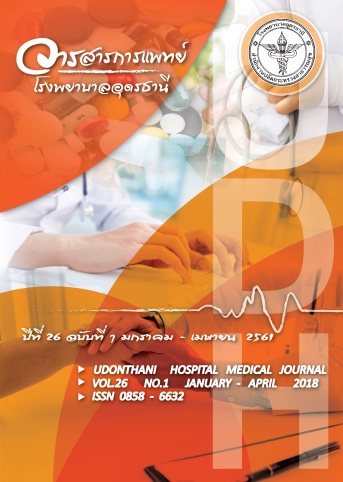รายงานผลการเพาะเชื้อจากกระแสเลือดในผู้ป่วยที่มาด้วยแผลกระเพาะอาหารทะลุ ในโรงพยาบาลเลย: การติดเชื้อ หรือปฏิกิริยาตอบสนอง ของร่างกาย?
คำสำคัญ:
แผลกระเพาะอาหารทะลุ, การเพาะเชื้อ, น้ำในช่องท้อง, เลยบทคัดย่อ
การศึกษาเชิงพรรณนาแบบเก็บข้อมูลย้อนหลัง (Retrospective descriptive study) มีวัตถุประสงค์เพื่อศึกษาลักษณะทั่วไปของประชากรได้แก่ เพศ, อายุ, การใช้ยากลุ่ม NSAIDs, ระยะเวลาตั้งแต่เริ่มปวดจนถึงได้รับการผ่าตัด, สิ่งที่พบในการผ่าตัด (Operative finding) ได้แก่ การปนเปื้อน (contamination), ชนิดของแผล (type of ulcer by Modified Johnson Classification), ขนาดของแผล (size of ulcer), แหล่งและผลการเพาะเชื้อทางห้องปฏิบัติการ, ภาวะแทรกซ้อนและอัตราการตาย (complications and mortality) ในผู้ป่วยที่มาด้วยแผลกระเพาะอาหารทะลุ เพื่อดูแนวโน้มว่าผู้ป่วยที่มาด้วยแผลกระเพาะอาหารทะลุน่าจะเป็นการติดเชื้อหรือแค่ปฏิกิริยาของร่างกาย เพื่อจัดทำแนวทางการให้ยาปฏิชีวนะ กลุ่มตัวอย่างคือ ผู้ป่วยทั้งหมดที่เข้ารับการรักษาด้วยโรคแผลกระเพาะอาหารทะลุและได้รับการผ่าตัดรักษาในโรงพยาบาลเลย ตั้งแต่ 1 พฤษภาคม พ.ศ. 2555 ถึง 30 มิถุนายน พ.ศ. 2557 จำนวนทั้งสิ้น 107 ราย โดยรวบรวมข้อมูลจากเวชระเบียนผู้ป่วยนอก และผู้ป่วยใน บันทึกการผ่าตัดของโรงพยาบาลเลย จังหวัดเลย วิเคราะห์ข้อมูลด้วยสถิติเชิงพรรณนา ใช้ร้อยละ ค่าเฉลี่ย ส่วนเบี่ยงเบนมาตรฐาน, สถิติวิเคราะห์ใช้ Chi-square และ the Mann-Whitney rank sum test สำหรับข้อมูล non-parametric และ Test for Equality of Variances โดยกำหนดระดับนัยสำคัญทางสถิติ ที่ 0.05 (p=0.05)
ผลการศึกษา กลุ่มตัวอย่าง 107 ราย เป็นเพศชายร้อยละ 89.7 อายุระหว่าง 25-86 ปี เฉลี่ย 58.76 (S.D. 14.1) พบว่าใช้ยากลุ่ม NSAIDs ร้อยละ 75.7 ชนิดของแผลเป็น type V ร้อยละ 75.7 ส่งเพาะเชื้อในกระแสเลือด 102 ราย พบการติดเชื้อ (hemoculture positive) 12 ราย (ร้อยละ11.7) โดยเป็นเชื้อ Staphylococcus coagulase negative , จำนวน 8 ราย (ร้อยละ7.8) พบการติดเชื้อจากน้ำในช่องท้อง (ascites fluid culture positive) 25 ราย (ร้อยละ23.4) จาก 107 รายโดยเป็นกลุ่ม Gram negative bacteria, Yeast และ Gram positive bacteria จำนวน 17, 13 และ 10 ราย คิดเป็นร้อยละ 15.9, 12.1 และ 9.3 ตามลำดับ และพบว่าการปนเปื้อนมีผลต่อการเพาะเชื้อจากน้ำในช่องท้อง (ascites fluid culture) โดยมีผลต่อภาวะแทรกซ้อนและอัตราตายที่สูงขึ้นโดยเฉพาะถ้าขึ้นยีสต์ และเชื้อแบคทีเรียในกลุ่มที่เพาะเชื้อขึ้นจากน้ำในช่องท้องจะตอบสนองต่อยาปฏิชีวนะ ceftriaxone, gentamicin และ ampicillin/penicillin ร้อยละ 85.2, ร้อยละ 63.0 และ ร้อยละ 37.0 ตามลำดับ
สรุป แนวโน้มผู้ป่วยที่มาด้วยแผลกระเพาะอาหารทะลุและมีภาวะแทรกซ้อนในการศึกษานี้ น่าจะเป็นเรื่องของปฏิกิริยาของร่างกายมากกว่าที่จะเป็นการติดเชื้อจริง โดยเชื้อส่วนใหญ่เป็น yeast และ gram negative bacteria โดยถ้าการติดเชื้อจากน้ำในช่องท้องขึ้นเชื้อยีสต์จะมีผลต่อภาวะแทรกซ้อนและอัตราตายที่สูงขึ้น ต้องเฝ้าระวังมากขึ้น ควรนำผลการศึกษาที่ได้มาจัดทำแนวทางการใช้ยาปฏิชีวนะ และนำปัจจัยเสี่ยงที่ตรวจพบมาใช้ในการพัฒนาการดูแลผู้ป่วยที่มาด้วยแผลกระเพาะอาหารทะลุให้ดียิ่งขึ้น
References
2. ธนิต รัตนธรรมสกุล, ชาโล สาณศิลปิน, ชนาพัฒน์ศรีนครินทร์, เอนก มุ่งอ้อมกลาง, ปณิธี ธัมมวิจยะ, จักรรัฐ พิทยาวงศ์อานนท์. การสอบสวนการระบาดของภาวะแผลเปื่อยทางเดินอาหารทะลุในอำเภอบัวใหญ่ บัวลาย และสีดา จังหวัดนครราชสีมา พ.ศ. 2558. รายงานการเฝ้าระวังทางระบาดวิทยาประจำสัปดาห์ 2560; 48: 65-73. [Internet]; Access 5 August 2017. Available from http://www.wesr.moph.go.th/wesr_new/fle/y60/H6052017012920170204.pdf
3. Arici C, Mesci A, Dincer D, Dinckan A, Colak T. Analysis of risk factors predicting (affecting) mortality and morbidity of peptic ulcer perforations. Int Surg. 2007 May-Jun;92(3): 147-54.
4. J.Boey , J. WONG, A Prospective Study of Operative Risk Factors in Perforated Duodenal Ulcers Ann. Surg. March 1982, 265-269.
5. Suriya C, Kasatpibal N, Kunaviktikul W, and Kayee T. Prognostic Factors and Complications in Patients With Operational Peptic Ulcer Perforation in Northern Thailand. Gastroenterology Res. 2014 Feb; 7(1): 5–11.
6. Carlos Noguiera, António Surgio Silva, Jorge Nunes Santos et al. Perforated Peptic Ulcer: Main Factors of Morbidity and Mortality July 2003, Volume 27, Issue 7, 782-787.
7. Reimar W Thomsen MD, PhD, Anders Riis MSc, Estrid M Munk MD, Mette Nørgaard MD, PhD, 30-Day Mortality After Peptic Ulcer Perforation Among Users of Newer Selective Cox-2 Inhibitors and Traditional NSAIDs: A Population-Based Study The American Journal of Gastroenterology (2006) 101, 2704-2710
8. DK Rohit, RS Verma, G Pandey. Clinical study and management of peritonitis secondary to perforated peptic ulcer. International Surgery Journal. August 2017;4(8):2721- 2726
9. RCG Russell, JN. Primrose. Stomach and duodenum. In: Norman S Williums, Christopher JK Bulstrode. Editor. Bailey and Love’s Short practice of surgery. 24th ed. London: Armold; 2004. 1045-6.
10. J. Boey, J. Wong, GB. Ong. Bacteria and septic complications in patients with perforated duodenal ulcers The American Journal of Surgery Volume 143, Issue 5, May 1982. 635-639.
11. Prakash A, Sharma D, Saxena A, Somashekar U, Khare N, Mishra A, Anvikar A. Effect of Candida infection on outcome in patients with perforation peritonitis. Indian J Gastroenterol. 2008 May-Jun;27(3):107-9.
12. SC Lee, CP Fung, HY Chen, et.al. Candida peritonitis due to peptic ulcer perforation: incidence rate, risk factors, prognosis and susceptibility to fluconazole and amphotericin B. Diagnostic Microbiology and Infectious Disease. Vol.44, Issue1,September 2002, 23-27.
13. Y.-S. Shan, H.-P. Hsu, Y.-H. Hsieh, et al. Signifcance of intraoperative peritoneal culture of fungus in perforated peptic ulcer. British Journal of Surgery. Volume 90, Issue 10.October 2003. 1215-1219
Downloads
เผยแพร่แล้ว
ฉบับ
บท
License
การละเมิดลิขสิทธิ์ถือเป็นความรับผิดชอบของผู้ส่งบทความโดยตรง
ผลงานที่ได้รับการตีพิมพ์ถือเป็นลิขสิทธิ์ของผู้นิพนธ์ ขอสงวนสิทธิ์มิให้นำเนื้อหา ทัศนะ หรือข้อคิดเห็นใด ๆ ของบทความในวารสารไปเผยแพร่ทางการค้าก่อนได้รับอนุญาตจากกองบรรณาธิการ อย่างเป็นลายลักษณ์อักษร


